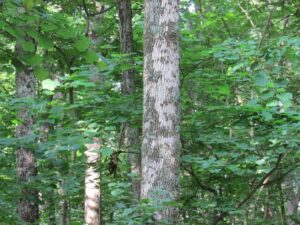Our Shenandoah Valley forests are taking another hit. A little over 100 years ago, the Chestnut Blight eliminated one of the most useful and stately trees in our woodlands. About 50 years later, the Hemlock Woolly Adelgid began to hammer our Eastern Hemlocks and many have succumbed to their relentless sap sucking. Then the Gypsy Moth swept through devastating many oak stands as well as other species. Remarkably, our forests have adapted and overcome these pests to remain strong, productive and beautiful.
Now it’s the Emerald Ash Borer. This small iridescent green insect is responsible for many of the dead and dying trees throughout our area. While the adults are relatively harmless, they lay the eggs that hatch into the larvae that effectively girdle the trees cutting off their supply of nutrients and water thus strangling the plants. Yard and forest trees both are dying by the millions and countless board feet of lumber that could otherwise be turned into baseball bats, tool handles, and beautiful furniture are doomed to decay and rot. Although yard trees can be saved with chemical applications, a large scale solution for our forest populations is not yet on the horizon. 
One of the early signs that a tree is suffering from this tiny pest is the light colored patches that appear on the bark. This phenomenon, known as blonding, is caused not by the bug, but by woodpeckers peeling away the outer bark in an attempt to reach the juicy larvae inside. In some cases, the entire tree trunk turns very light brown that initially adds variety to an otherwise dull forest canopy. Unfortunately, blonding is a sign of impending death. Even though the woodpeckers themselves cause little or no permanent damage, the patterns they create reveal deeper problems that will soon result in mortality. Conditions on the interior, though not readily visible, are manifested through secondary exterior signs.
This same phenomenon happens with us. While others are not able to see into our souls, our countenances usually reveal our inner feelings and thoughts. Our facial expressions often reflect our heart conditions whether they be ones of joy and happiness or sadness and worry. Some are better at poker faces than others, but conversations, attitudes, appearances, and dispositions eventually expose what’s inside.
Blonding can help us understand and extend empathy to our friends, family members, and coworkers. Although they may not readily share inner struggles, their appearances and moods often reflect what they are thinking and feeling. When daily stresses result in unusually snappy comments or angry responses, this indicates more about what’s going on within them than how they feel about us. Such inner turmoil does not excuse bad behavior, but it may be a root cause of it. If we are observant, we can often spot these conditions and this will help us extend grace, offer prayer and support, and share patience.
Blonding may also help us help ourselves. We may be able to conceal our true feelings and inner hurts for a while, but sooner or later outward signs of these become apparent. While these indicators may seem unrelated and even harmless at first, they often signal deeper problems that will result in our spiritual demise if we do not address them. If we are self-aware, we can recognize these outward signs in ourselves even if we are unaware of our inner conditions. Wise self-examination can result in personal growth and beneficial elimination of hidden sins, attitudes, and unforgiveness before these soul pests strangle the spiritual life out of us.
Although we may lose the amazingly beautiful and beneficial ash trees from our forest family, God has engineered our ecosystems with incredible flexibility. The ash niche will be filled by other species as the woodlands adjust and adapt yet again, even to harmful change. But before the ash trees disappear, let’s thank their Creator for their presence and gifts and let’s understand the lessons they can teach us about outward signs of our inner conditions. Thanking God for the ash tree, George